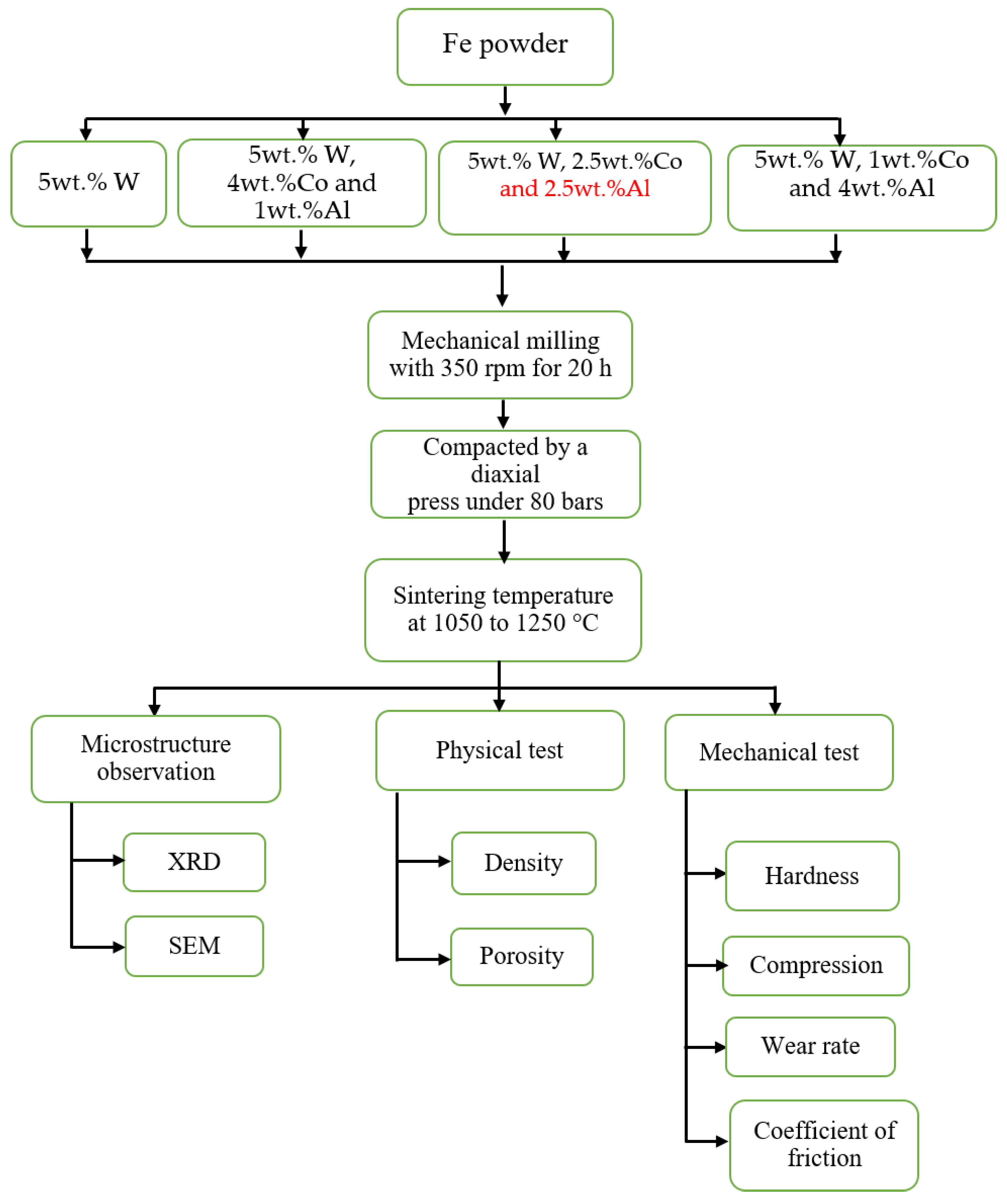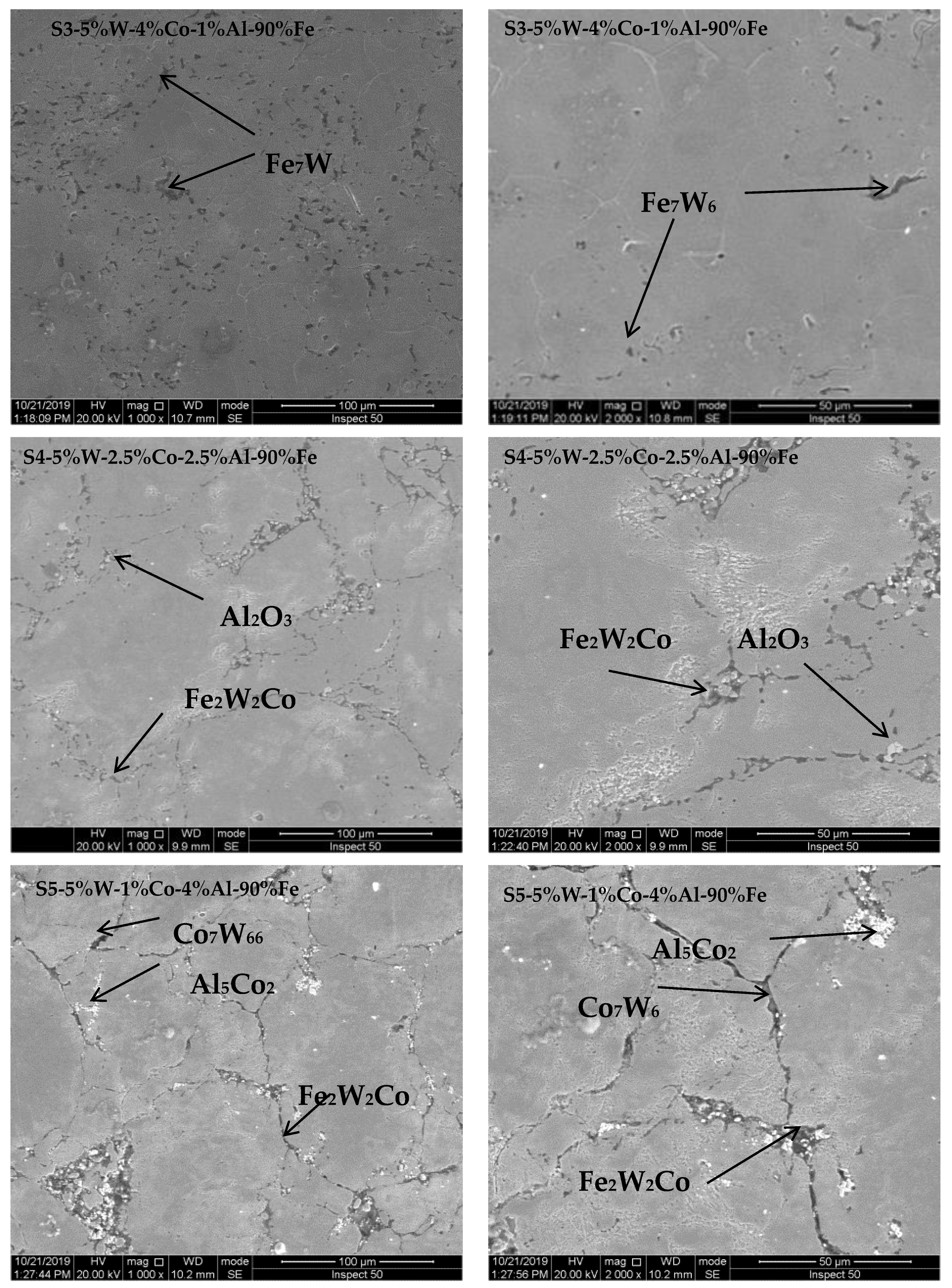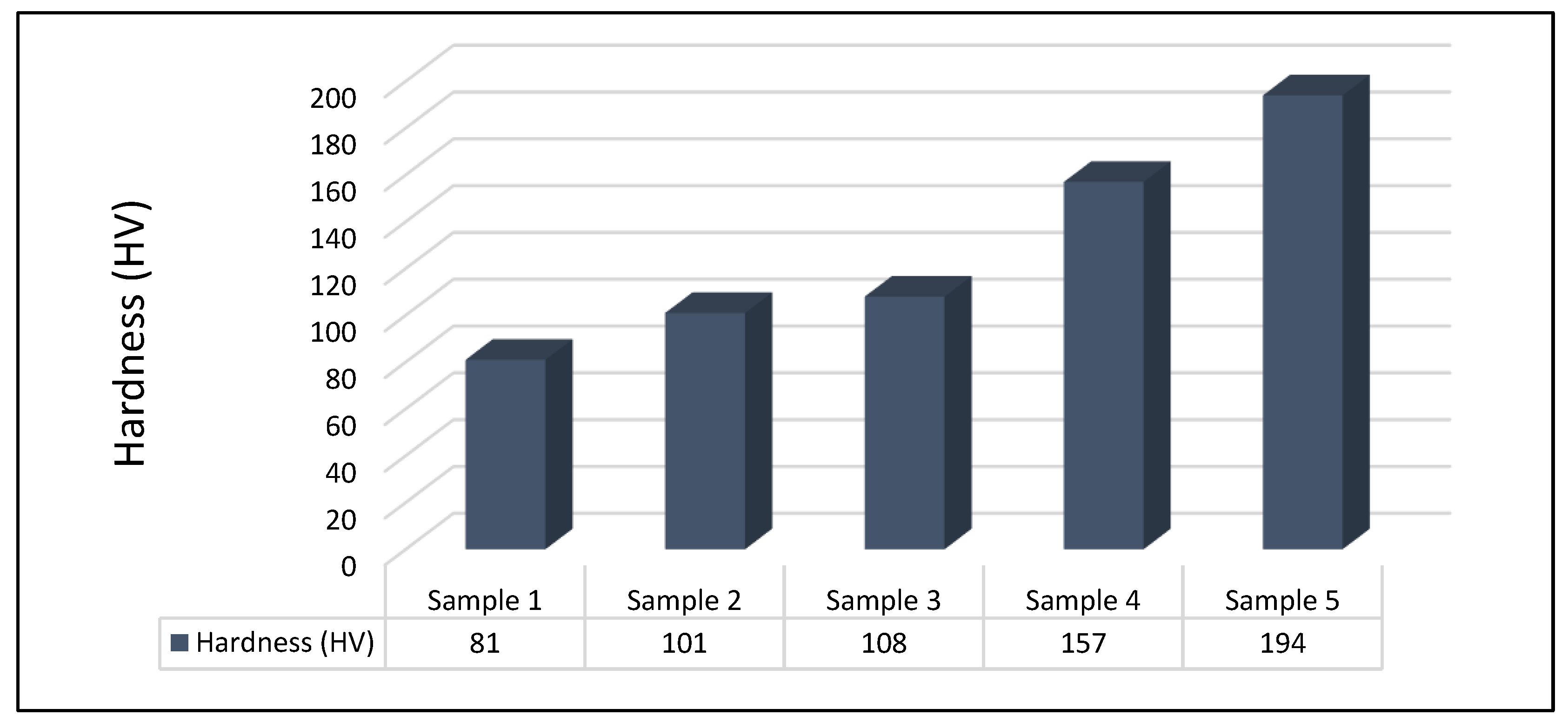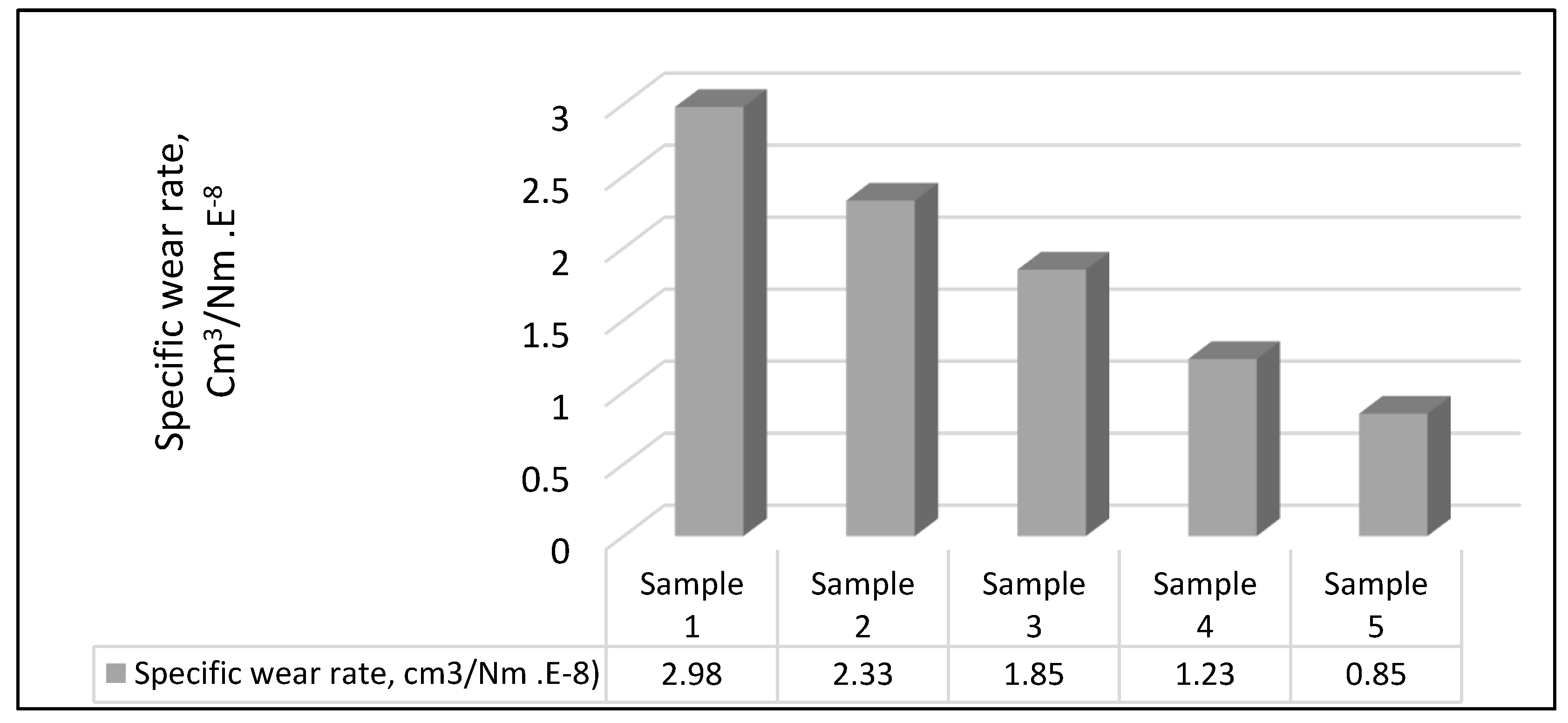Impact of Using Tungsten, Cobalt, and Aluminum Additives on the Tribological and Mechanical Properties of Iron Composites
Abstract
:1. Introduction
2. Experimentation
3. Characterizations
3.1. Density of Sintered Samples
3.2. Microstructure Investigation
3.3. Mechanical Properties
3.3.1. Compressive Testing
3.3.2. Surface Hardness
3.4. Tribological Testing
3.4.1. Friction Coefficient
3.4.2. Wear Rate
4. Results and Discussion
4.1. Composition and Phase Structure
4.2. Density Estimation
4.3. Microstructure Investigation
5. Effect of W, Al and Co on the Properties of Bearing Material
Vickers Hardness
6. Compressive Strength
6.1. Specific Wear Rate
6.2. Friction Coefficient
6.3. Comparison Overview
7. Conclusions
- (1)
- The relative density was slightly affected by the W, Co, and Al additions. All produced composites had relative density ranges from (93~97.4%).
- (2)
- The highest relative density (97.4%) was obtained for the composite that contained 5% W, 2.5% Co, and 2.5% Al.
- (3)
- XRD results indicated the formation of intermetallic compounds between Fe, W, Co, and Al which improved the mechanical properties.
- (4)
- The largest hardness (192 HV) was obtained for the composite that contained 5% W, 1% Co, and 4% Al, which is higher than that of a pure Fe matrix by about 240%.
- (5)
- Compressive strength was affected greatly by the addition of 5% W, which was increased by 35% compared to pure Fe powder, and this increase was slightly affected by Al and Co additions.
- (6)
- The composite that contained 5% W, 1% Co, and 4% Al had the largest hardness, the largest wear resistance, and the lowest friction coefficient when compared with a pure Fe matrix. This composite (5% W, 1% Co, 4% Al) is a good candidate for bearing materials at severe mechanical and tribological conditions for both static and dynamic loadings.
Author Contributions
Funding
Acknowledgments
Conflicts of Interest
References
- Elsheikh, A.H.; Abd Elaziz, M.; Ramesh, B.; Egiza, M.; Al-qaness, M.A.A. Modeling of Drilling Process of GFRP Composite Using a Hybrid Random Vector Functional Link Network/Parasitism-Predation Algorithm. J. Mater. Res. Technol. 2021, 14, 298–311. [Google Scholar] [CrossRef]
- Showaib, E.A.; Elsheikh, A.H. Effect of Surface Preparation on the Strength of Vibration Welded Butt Joint Made from PBT Composite. Polym. Test. 2020, 83, 106319. [Google Scholar] [CrossRef]
- Thangaraj, M.; Ahmadein, M.; Alsaleh, N.A.; Elsheikh, A.H. Optimization of Abrasive Water Jet Machining of SiC Reinforced Aluminum Alloy Based Metal Matrix Composites Using Taguchi–DEAR Technique. Materials 2021, 14, 6250. [Google Scholar] [CrossRef] [PubMed]
- Elsheikh, A.H.; Panchal, H.; Shanmugan, S.; Muthuramalingam, T.; El-Kassas, A.M.; Ramesh, B. Recent Progresses in Wood-Plastic Composites: Pre-Processing Treatments, Manufacturing Techniques, Recyclability and Eco-Friendly Assessment. Clean. Eng. Technol. 2022, 8, 100450. [Google Scholar] [CrossRef]
- Kamal, A.; Ashmawy, M.; Algazzar, A.M.; Elsheikh, A.H. Fabrication Techniques of Polymeric Nanocomposites: A Comprehensive Review. Proc. Inst. Mech. Eng. Part C J. Mech. Eng. Sci. 2021, 236, 4843–4861. [Google Scholar] [CrossRef]
- Abu-Okail, M.; Alsaleh, N.A.; Farouk, W.M.; Elsheikh, A.; Abu-Oqail, A.; Abdelraouf, Y.A.; Ghafaar, M.A. Effect of Dispersion of Alumina Nanoparticles and Graphene Nanoplatelets on Microstructural and Mechanical Characteristics of Hybrid Carbon/Glass Fibers Reinforced Polymer Composite. J. Mater. Res. Technol. 2021, 14, 2624–2637. [Google Scholar] [CrossRef]
- Elsheikh, A.H.; Guo, J.; Huang, Y.; Ji, J.; Lee, K.-M. Temperature Field Sensing of a Thin-Wall Component during Machining: Numerical and Experimental Investigations. Int. J. Heat Mass Transf. 2018, 126, 935–945. [Google Scholar] [CrossRef]
- Elsheikh, A. Bistable Morphing Composites for Energy-Harvesting Applications. Polymers 2022, 14, 1893. [Google Scholar] [CrossRef]
- Liu, Y.; Jiang, Y.; Zhou, R.; Feng, J. First-Principles Calculations of the Mechanical and Electronic Properties of Fe–W–C Ternary Compounds. Comput. Mater. Sci. 2014, 82, 26–32. [Google Scholar] [CrossRef]
- Zhou, H.; Wu, C.; Tang, D.; Shi, X.; Xue, Y.; Huang, Q.; Zhang, J.; Elsheikh, A.H.; Ibrahim, A.M.M. Tribological Performance of Gradient Ag-Multilayer Graphene/TC4 Alloy Self-Lubricating Composites Prepared By Laser Additive Manufacturing. Tribol. Trans. 2021, 64, 819–829. [Google Scholar] [CrossRef]
- Li, Y.; Gao, Y. Three-Body Abrasive Wear Behavior of CC/High-Cr WCI Composite and Its Interfacial Characteristics. Wear 2010, 268, 511–518. [Google Scholar] [CrossRef]
- Essa, F.A.; Yu, J.; Elsheikh, A.H.; Tawfik, M.M. A New M50 Matrix Composite Sintered with a Hybrid Sns/Zno Nanoscale Solid Lubricants: An Experimental Investigation. Mater. Res. Express 2019, 6, 116523. [Google Scholar] [CrossRef]
- Elsheikh, A.H.; Yu, J.; Sathyamurthy, R.; Tawfik, M.M.; Shanmugan, S.; Essa, F.A. Improving the Tribological Properties of AISI M50 Steel Using Sns/Zno Solid Lubricants. J. Alloys Compd. 2020, 821, 153494. [Google Scholar] [CrossRef]
- Ahmadein, M.; El-Kady, O.A.; Mohammed, M.M.; Essa, F.A.; Alsaleh, N.A.; Djuansjah, J.; Elsheikh, A.H. Improving the Mechanical Properties and Coefficient of Thermal Expansion of Molybdenum-Reinforced Copper Using Powder Metallurgy. Mater. Res. Express 2021, 8, 96502. [Google Scholar] [CrossRef]
- Mohammed, M.M.; Elsayed, E.M.; El-Kady, O.A.; Alsaleh, N.A.; Elsheikh, A.H.; Essa, F.A.; Ahmadein, M.; Djuansjah, J. Electrochemical Behavior of Cu-MWCNT Nanocomposites Manufactured by Powder Technology. Coatings 2022, 12, 409. [Google Scholar] [CrossRef]
- Cui, G.; Lu, L.; Wu, J.; Liu, Y.; Gao, G. Microstructure and Tribological Properties of Fe–Cr Matrix Self-Lubricating Composites against Si3N4 at High Temperature. J. Alloys Compd. 2014, 611, 235–242. [Google Scholar] [CrossRef]
- Cui, G.; Kou, Z. The Effect of Boron on Mechanical Behavior and Microstructure for Fe–Cr Matrix Alloy Prepared by P/M. J. Alloys Compd. 2014, 586, 699–702. [Google Scholar] [CrossRef]
- Suh, J.Y.; Bae, D.H. Mechanical Properties of Fe-Based Composites Reinforced with Multi-Walled Carbon Nanotubes. Mater. Sci. Eng. A 2013, 582, 321–325. [Google Scholar] [CrossRef]
- Merie, V.V.; Cândea, V.C.; Bîrleanu, C.; Păşcuţă, P.; Popa, C.O. The Influence of Titanium Dioxide on the Tribological Characteristics of a Fe-Based Friction Composite Material. J. Compos. Mater. 2014, 48, 235–243. [Google Scholar] [CrossRef]
- Kostornov, A.G.; Fushchich, O.I.; Chevychelova, T.M.; Kostenko, A.D.; Karpets, M. V Tribological Characteristics of the Iron-Based Composite at 500 C. Powder Metall. Met. Ceram. 2014, 53, 411–416. [Google Scholar] [CrossRef]
- Kang, N.; Zhang, Y.; El Mansori, M.; Lin, X. Laser Powder Bed Fusion of a Novel High Strength Quasicrystalline Al–Fe–Cr Reinforced Al Matrix Composite. Adv. Powder Mater. 2023, 2, 100108. [Google Scholar] [CrossRef]
- Gao, J.; Li, T.; Yan, Z.; Liu, S.; Zhao, Y.; Tong, W. Research on the Interface and Properties of Spherical ZTA Particles Reinforced Fe-Cr-B Matrix Composite. J. Mater. Res. Technol. 2022, 19, 1322–1331. [Google Scholar] [CrossRef]
- Pashangeh, S.; Alizadeh, M.; Amini, R. Structural and Corrosion Behavior Investigation of Novel Nano-Quasicrystalline Al-Cr-Fe Reinforced Al-Matrix Composites Produced by ARB Process. J. Alloys Compd. 2022, 890, 161774. [Google Scholar] [CrossRef]
- Somunkiran, I.; Buytoz, S.; Dagdelen, F. Determination of Curie Temperatures and Thermal Oxidation Behavior of Fe-Cr Matrix Composites Produced by Hot Pressing. J. Alloys Compd. 2019, 777, 302–308. [Google Scholar] [CrossRef]
- Kang, N.; Fu, Y.; Coddet, P.; Guelorget, B.; Liao, H.; Coddet, C. On the Microstructure, Hardness and Wear Behavior of Al-Fe-Cr Quasicrystal Reinforced Al Matrix Composite Prepared by Selective Laser Melting. Mater. Des. 2017, 132, 105–111. [Google Scholar] [CrossRef]
- Chen, B.; Li, X.; Jia, Y.; Li, X.; Zhang, M.; Dong, J. Tribological Properties of Fe–Ni-Based Composites with Ni-Coated Reduced Graphene Oxide–MoS2. J. Compos. Mater. 2018, 52, 2631–2639. [Google Scholar] [CrossRef]
- Bai, H.; Zhong, L.; Cui, P.; Lv, Z.; Xu, Y. Preparation of V8C7-Fe/Iron Dual-Scale Composite via Two-Step in Situ Reaction. J. Mater. Res. Technol. 2020, 9, 4114–4122. [Google Scholar] [CrossRef]
- Jiang, J.; Li, S.; Hu, S.; Zhang, J.; Yu, W.; Zhou, Y. Comparison of High Cr White Iron Composites Reinforced with Directly Added TiC and in Situ Formed TiCx. J. Mater. Res. Technol. 2020, 9, 3140–3148. [Google Scholar] [CrossRef]
- Wei, A.; Tang, Y.; Tong, T.; Wan, F.; Yang, S.; Wang, K. Effect of WC on Microstructure and Wear Resistance of Fe-Based Coating Fabricated by Laser Cladding. Coatings 2022, 12, 1209. [Google Scholar] [CrossRef]
- Li, X.; Shi, Y.; Wang, S. Investigation of the Phase Transformation Characteristics of Fe-Co Elastrocalaric Refrigeration Alloy. J. Phys. Conf. Ser. 2021, 2076, 12033. [Google Scholar] [CrossRef]
- Zhang, Z.; Fan, G.; Tan, Z.; Zhao, H.; Xu, Y.; Xiong, D.; Li, Z. Towards the Strength-Ductility Synergy of Al2O3/Al Composite through the Design of Roughened Interface. Compos. Part B Eng. 2021, 224, 109251. [Google Scholar] [CrossRef]
- De Groot, P.J. The Meaning and Measure of Vertical Resolution in Optical Surface Topography Measurement. Appl. Sci. 2017, 7, 54. [Google Scholar] [CrossRef] [Green Version]
- Podulka, P. Selection of Methods of Surface Texture Characterisation for Reduction of the Frequency-Based Errors in the Measurement and Data Analysis Processes. Sensors 2022, 22, 791. [Google Scholar] [CrossRef] [PubMed]
- Haitjema, H. Uncertainty in Measurement of Surface Topography. Surf. Topogr. Metrol. Prop. 2015, 3, 35004. [Google Scholar] [CrossRef]
- Zhang, X.; Lai, L.; Xiao, S.; Zhang, H.; Zhang, F.; Li, N.; Guo, S. Effect of W on the Thermal Stability, Mechanical Properties and Corrosion Resistance of Fe-Based Bulk Metallic Glass. Intermetallics 2022, 143, 107485. [Google Scholar] [CrossRef]
- Elsayed, A.; Li, W.; El Kady, O.A.; Daoush, W.M.; Olevsky, E.A.; German, R.M. Experimental Investigations on the Synthesis of W–Cu Nanocomposite through Spark Plasma Sintering. J. Alloys Compd. 2015, 639, 373–380. [Google Scholar] [CrossRef]
- Elsheikh, A.H.; El-Said, E.M.S.; Abd Elaziz, M.; Fujii, M.; El-Tahan, H.R. Water Distillation Tower: Experimental Investigation, Economic Assessment, and Performance Prediction Using Optimized Machine-Learning Model. J. Clean. Prod. 2023, 388, 135896. [Google Scholar] [CrossRef]
- Moustafa, E.B.; Elsheikh, A. Predicting Characteristics of Dissimilar Laser Welded Polymeric Joints Using a Multi-Layer Perceptrons Model Coupled with Archimedes Optimizer. Polymers 2023, 15, 233. [Google Scholar] [CrossRef]
- Khoshaim, A.B.; Moustafa, E.B.; Bafakeeh, O.T.; Elsheikh, A.H. An Optimized Multilayer Perceptrons Model Using Grey Wolf Optimizer to Predict Mechanical and Microstructural Properties of Friction Stir Processed Aluminum Alloy Reinforced by Nanoparticles. Coatings 2021, 11, 1476. [Google Scholar] [CrossRef]









| Material | wt. % | ||||
|---|---|---|---|---|---|
| Specimen #1 | Specimen #2 | Specimen #3 | Specimen #4 | Specimen #5 | |
| Fe | 100% | 95% | 90% | 90% | 90% |
| W | - | 5% | 5% | 5% | 5% |
| Co | - | - | 4% | 2.5% | 1% |
| Al | - | - | 1% | 2.5% | 4% |
| Sample area | 85 mm2 | Test duration | 18 min |
| Sliding speed | 7 m/s | Ambient temperature | 25 °C |
| Friction pressure | 0.5 MPa |
| C % | Mn % | Si % | S % | Ni % | Cr % | Mo % |
|---|---|---|---|---|---|---|
| 3.3–3.5 | 0.6–0.9 | 1.8–2.1 | 0.12 | 0.6–0.7 | 0.15–0.25 | 0.2–0.3 |
| Materials | Specimen #1 | Specimen #2 | Specimen #3 | Specimen #4 | Specimen #5 |
|---|---|---|---|---|---|
| W content, wt.% | 0% | 5% | 5% | 5% | 5% |
| Co content, wt.% | 0% | 0% | 4% | 2.5% | 1% |
| Al content, wt.% | 0% | 0% | 1% | 2.5% | 4% |
| Relative Density, % | 96.2 | 92.6 | 93.8 | 97.3 | 94.5 |
| Standard Deviation | 7.94 | 6.36 | 7.06 | 7.79 | 6.32 |
| Compressive strength, MPa | 270 | 360 | 360 | 360 | 350 |
| Hardness, HV | 81 | 101 | 108 | 157 | 194 |
| Friction coefficient | 0.62 | 0.58 | 0.57 | 0.57 | 0.53 |
| Specific wear rate, SWR, cm3/Nm | 2.98 × 10−8 | 2.33 × 10−8 | 1.85 × 10−8 | 1.23 × 10−8 | 0.85 × 10−8 |
Disclaimer/Publisher’s Note: The statements, opinions and data contained in all publications are solely those of the individual author(s) and contributor(s) and not of MDPI and/or the editor(s). MDPI and/or the editor(s) disclaim responsibility for any injury to people or property resulting from any ideas, methods, instructions or products referred to in the content. |
© 2023 by the authors. Licensee MDPI, Basel, Switzerland. This article is an open access article distributed under the terms and conditions of the Creative Commons Attribution (CC BY) license (https://creativecommons.org/licenses/by/4.0/).
Share and Cite
Mohammed, M.M.; Alrasheedi, N.H.; El-Kady, O.A.; Djuansjah, J.; Essa, F.A.; Elsheikh, A.H. Impact of Using Tungsten, Cobalt, and Aluminum Additives on the Tribological and Mechanical Properties of Iron Composites. Crystals 2023, 13, 395. https://doi.org/10.3390/cryst13030395
Mohammed MM, Alrasheedi NH, El-Kady OA, Djuansjah J, Essa FA, Elsheikh AH. Impact of Using Tungsten, Cobalt, and Aluminum Additives on the Tribological and Mechanical Properties of Iron Composites. Crystals. 2023; 13(3):395. https://doi.org/10.3390/cryst13030395
Chicago/Turabian StyleMohammed, Moustafa M., Nashmi H. Alrasheedi, Omayma A. El-Kady, Joy Djuansjah, Fadl A. Essa, and Ammar H. Elsheikh. 2023. "Impact of Using Tungsten, Cobalt, and Aluminum Additives on the Tribological and Mechanical Properties of Iron Composites" Crystals 13, no. 3: 395. https://doi.org/10.3390/cryst13030395








